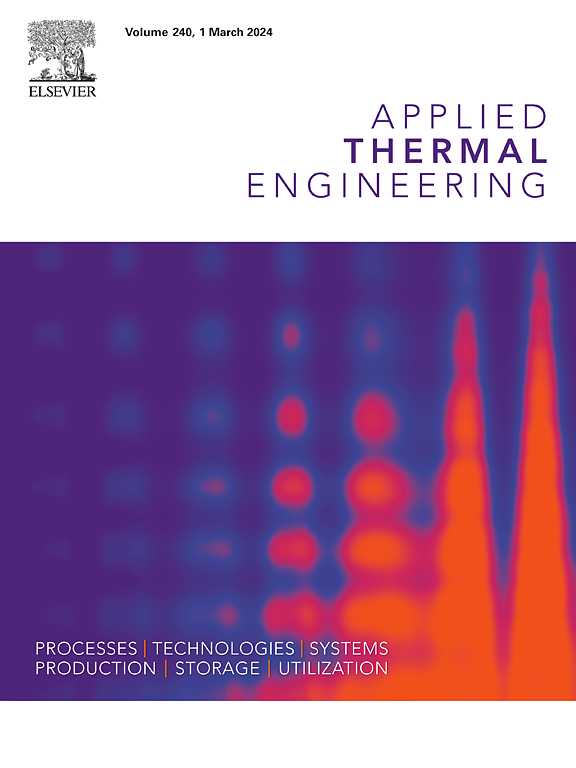热储箱内混沌螺旋交换器周围的外部交换
IF 6.1
2区 工程技术
Q2 ENERGY & FUELS
引用次数: 0
摘要
本研究比较了两种换热器几何形状——混沌螺旋换热器(CHE)和螺旋换热器(HHE)在不同流量下浸入储热槽内的外换热性能和能量效率。外部传热性能是指换热器在其表面和周围流体之间传递热量的能力,这对于优化储能系统的能效至关重要。这项工作的新颖之处在于将基于混沌平流的热交换器集成到储热系统中,这是一个在文献中尚未探索的主题。实验方法包括无因次温度(θ)分析和外部传热系数(h)的测量。结果表明,CHE保持一致且可预测的传热过程,θ在所有流量下均匀减小至平衡,而HHE对流量敏感,θ在稳定前出现初始波动。在大多数流速下,两种几何形状的外换热系数相似,但在中等流速下略有不同。此外,温度比分析显示,CHE始终保持均匀的温度分布(比值= 0.99),而HHE则呈现出初始峰值和非均匀性,然后趋于稳定。这些结果表明,CHE在保持均匀传热和最小化能量损失方面更有效,使其成为节能换热器设计的更好选择。热稳定性和性能的增强直接有助于降低能耗,特别是在需要一致热调节的系统中。本文章由计算机程序翻译,如有差异,请以英文原文为准。
External exchanges around a Chaotic Helix Exchanger in a thermal energy storage tank
This study compares the external heat transfer performances and energy efficiency of two heat exchanger geometries, Chaotic Helix Exchanger (CHE) and Helical Heat Exchanger (HHE), under varying flow rates, immersed in a thermal energy storage tank. External heat transfer performance refers to the ability of the heat exchanger to transfer heat between its surface and the surrounding fluid, which is crucial for optimizing energy efficiency in storage systems. The novelty of this work lies in the integration of chaotic advection-based heat exchangers into thermal storage systems, a topic that remains unexplored in the literature. Experimental methods involved dimensionless temperature () analyses and measurements of the external heat transfer coefficient (). Results indicated that CHE maintained a consistent and predictable heat transfer process, with decreasing uniformly to equilibrium across all flow rates, while HHE showed sensitivity to flow rates, with initial fluctuations in before stabilization. The external heat transfer coefficients were similar for both geometries at most flow rates but differed slightly at intermediate rates. Additionally, temperature ratio analysis revealed that CHE consistently maintained a uniform temperature distribution (ratio = 0.99), while HHE exhibited initial peaks and non-uniformities before stabilizing. These findings show that CHE is more efficient in maintaining uniform heat transfer and minimizing energy losses, making it the better choice for energy-efficient heat exchanger design. The enhanced thermal stability and performance of CHE directly contribute to reducing energy consumption, especially in systems requiring consistent thermal regulation.
求助全文
通过发布文献求助,成功后即可免费获取论文全文。
去求助
来源期刊

Applied Thermal Engineering
工程技术-工程:机械
CiteScore
11.30
自引率
15.60%
发文量
1474
审稿时长
57 days
期刊介绍:
Applied Thermal Engineering disseminates novel research related to the design, development and demonstration of components, devices, equipment, technologies and systems involving thermal processes for the production, storage, utilization and conservation of energy, with a focus on engineering application.
The journal publishes high-quality and high-impact Original Research Articles, Review Articles, Short Communications and Letters to the Editor on cutting-edge innovations in research, and recent advances or issues of interest to the thermal engineering community.
 求助内容:
求助内容: 应助结果提醒方式:
应助结果提醒方式:


